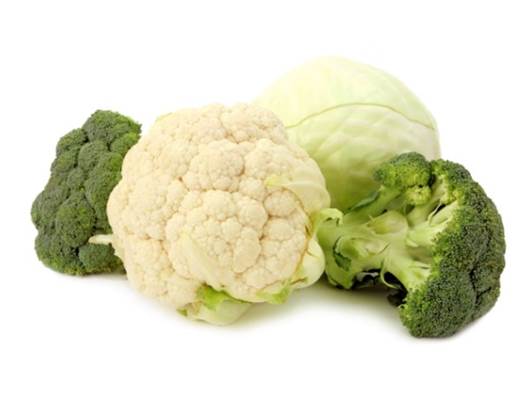Studies have also linked cruciferous
vegetables to a reduced risk of bladder, colon, lung, and other cancers and
have attributed this to their unique phytochemicals. Most recently, an analysis
of 13 existing studies from the U.S., Europe, and China, linked cruciferous
vegetables to a 15 per cent reduced risk of breast cancer in postmenopausal
women.

Studies
have also linked cruciferous vegetables to a reduced risk of bladder, colon,
lung, and other cancers and have attributed this to their unique phytochemicals.
One particular cruciferous vegetable,
broccoli, is an especially good source of sulforaphane, which is formed from
another compound, glucosinolate, when the vegetable is cut, chopped, chewed,
and digested. According to testtube studies, sulforaphane may inhibit cancer,
in part, by boosting production of enzymes that detoxify carcinogens and
inhibiting other enzymes that activate carcinogens. In addition, phytochemicals
in broccoli may reduce the spread of cancer cells or cause them to self-destruct.
Learning to love cabbage
Even with all their benefits, cruciferous
vegetables are difficult for some people to digest. Cabbages, broccoli and
cauliflower do have a strong flavor, but how the food is prepared makes a big
difference. One way around the bitterness of crucifers, as a 2011 study in
young children found, is to mask the taste by dipping the veggies in a light
salad dressing. Cauliflower, for example, is absolutely delicious when it’s
drizzled with a little oil and garam masala and roasted in a hot oven until
tender; there’s no bitterness at all. And broccoli and garlic stirfries are a
classic combo. These vegetables are also well-known for their less attractive
properties of producing bloating (gas) and flatulence. Cooking helps to break
down some of the indigestible carbohydrates, which are the gas-causing
culprits. The culprit is a complex sugar called raffinose, which bacteria in
the large intestine feed on, releasing gas. If you don’t tolerate broccoli
well, try eating smaller portions more often, or try an enzyme product (like
Gas-X or Beano Prevention or its generics) that helps break down the sugar so
it’s more digestible.

Cabbages,
broccoli and cauliflower do have a strong flavor, but how the food is prepared
makes a big difference.
Steaming them lightly or roasting them
rather than eating them raw also helps.
Get Creative
Here’s how to get more produce into your
diet:
Ø
Every time you eat, make a point to include a
fruit and/or a vegetable, and do your best to have half your plate made up of
fruits and vegetables.
Ø
Consider your overall eating pattern. Breakfast
should include fruit, lunch and dinner can include both vegetables and salads,
and fruit can be dessert after a meal or a between-meal snack.
Recipe: A greener salad

A
greener salad
Ingredients
·
2 cups broccoli and/or cauliflower florets
·
1 Tbsp. red wine vinegar
·
1 Tbsp. olive oil
·
½ tsp. minced garlic Salt and freshly ground
black pepper to taste
·
2 cups cherry tomatoes, stems removed and cut in
half
·
1 bunch watercress (chandrasur/brahmi sag/ahliv)
long stems trimmed, coarsely chopped
Instructions
1. In vegetable steamer set over boiling water, steam
cauliflower/broccoli, covered, until tender, about 4 minutes.
2. Rinse with cold water; drain well. In large bowl, whisk vinegar,
olive oil, garlic, salt, and black pepper.
3. Add all the veggies including tomatoes, and watercress.
4. Toss to blend. Serve immediately.
Makes 4 servings
·
Make fruits and vegetables available,
accessible, and easy to eat. Keep a bowl of fruit on your kitchen counter. Keep
cut-up veggies front and center in the refrigerator, so they’re the first thing
you see when you open the door.
·
Try new combinations. Add sliced citrus fruit to
a green salad, or shred some carrots or zucchini into your spaghetti, sauce or
soup. Follow the motto “If it grows together, it goes together.” For example,
try the Spanish sauce called romesco over grilled vegetables. It’s made from
roasted red peppers, olive oil, and nuts.
·
Pair veggies with small quantities of flavorful
oils such as sesame, mustard, olive oil and let them stand other. For e.g.,
make olive oil really shine by matching a bold olive oil, such as a Tuscan
varietal, with other bold flavors, such as rosemary and pine nuts (chilgoza).
Complement a milder olive oil, such as a French varietal, with subtly flavored
foods.